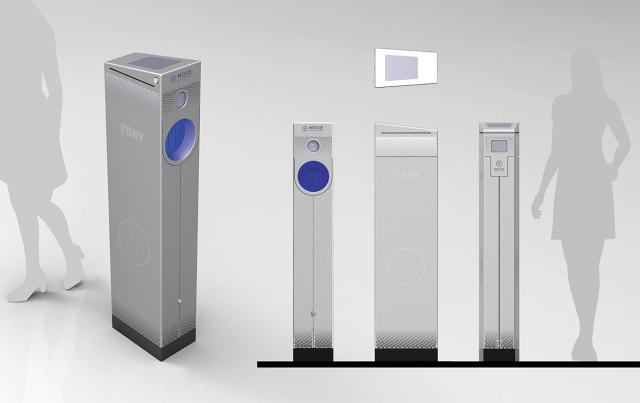Designed for FDNY emergency vehicles, these steel pedestals combat noise and emissions from idling engines.
To expedite responses to emergency calls, the New York Fire Department positions ambulances throughout the city. When you need an ambulance, you need it quickly. But all the down time between calls is not without costs. While the vehicles are parked, their engines are left running to power on-board communications systems and refrigerators (medicines must be temperature-controlled). Noise and emissions are byproducts of idling engines—well-documented nuisances that draw ire from residents living near ambulance stations. The FDNY has a design solution: build a network of plug-in charging pedestals.
Designed by Ignacio Ciocchini for the energy start-up MOVE Systems, the new FDNY ambulance pedestals are emblematic of a wave of infrastructure slowly creeping into New York that uses technology to combat some of the most pressing issues facing the city.

The pedestals—which recently earned an Excellence In Design award from the NYC Public Design Commission—are hooked up to the municipal power grid and connect to emergency vehicles using an automated retractable plug. It's estimated that one ambulance produces 45 tons of air pollution annually from engine idling. Multiply that by the hundreds of ambulances deployed throughout the city, and the amount of air pollution generated adds up. Every hour an ambulance idles, it burns 1.5 gallons of fuel, expels 33 pounds of carbon dioxide, and puts 35 to 50 miles worth of wear and tear on the engine, according to the trade publication Fire Apparatus magazine.
To Ciocchini—who has designed some of the most recognizable street furniture in New York City, like these city benches and these Bryant Park trash cans, and consulted on the WalkNYC wayfinding maps—the hallmark of well-designed street furniture is something that adds a positive element to the urban landscape and doesn't detract from the experience of walking down the street.

New York's sidewalks are crowded enough already so Ciocchini endeavored to fit all of the technical elements into as compact a package as possible. The pedestals stand about 4.5 feet tall, are 14 inches deep, and are 9 inches wide. Tucked inside is a plug that automatically extends from the kiosk when an ambulance approaches. The driver parks, then connects the plug and the ambulance receives power. If the ambulance receives an emergency call, the vehicle can drive off and the plug will automatically retract, ensuring that the technology doesn't hinder response times (and that it's theft-proof and isn't an eyesore). The pedestals have the same stainless steel look as other public furniture in New York, like its benches, walking signage, and Wi-Fi kiosks. Perforations let air ventilate the pedestal and prevent it from overheating. Ciocchini integrated a screen on the sidewalk side that lets passersby see how much air pollution was mitigated by using the electric chargers.
UX for the ambulance drivers was a key consideration. Each pedestal can self-perform diagnostics to make sure everything is ship shape and communicates its status via a cellular connection. A light around the power door shines blue when everything is working okay—a visual cue borrowed from consumer electronics that lets ambulance drivers know they can use the pedestal. The light turns orange if it's malfunctioning and tells drivers they can't plug in. Additionally, a brighter white light is up top, which helps drivers locate the pedestals in inclement weather.
The clever UX extends to the pedestal's inside, which is organized into three discrete sections: the base holds the electrical systems, like where it hooks up to the city's grid; the midsection has the electro-mechanical systems, like the charging cable; and the top hold's the pedestal's computer systems. Divvying it up in that way ensures that when maintenance is performed, the repair person knows exactly where he should be working and that his work doesn't accidentally damage another system.

So far, MOVE Systems has a contract to provide 30 pedestals that will begin to be installed in 2017. The initial deployment will focus on the Bronx, Queens, and Brooklyn though the intent is to have the citywide implementation. (Each proposed pedestal installation requires the FDNY to present the site plans for review and approval by the local community board.)
"I've been doing street furniture for 18 years, and it's exciting that technologies are starting to seep into these things and they're becoming smart, which benefits people in the city," Ciocchini says. "[The pedestals] are part of a solution to having a better city for everyone. There's really not a single product that can change your quality of life by itself. That's why a holistic view is important for all street furniture. When you apply [design] to a trash can, bench, newsstand, and light pole that's when it really makes a difference that is a lot more noticeable."
With the pedestals, NYC is showing how new urban infrastructure systems can make the city operate more smoothly and in an environmentally gentle way—and be a handsome addition to the streetscape.